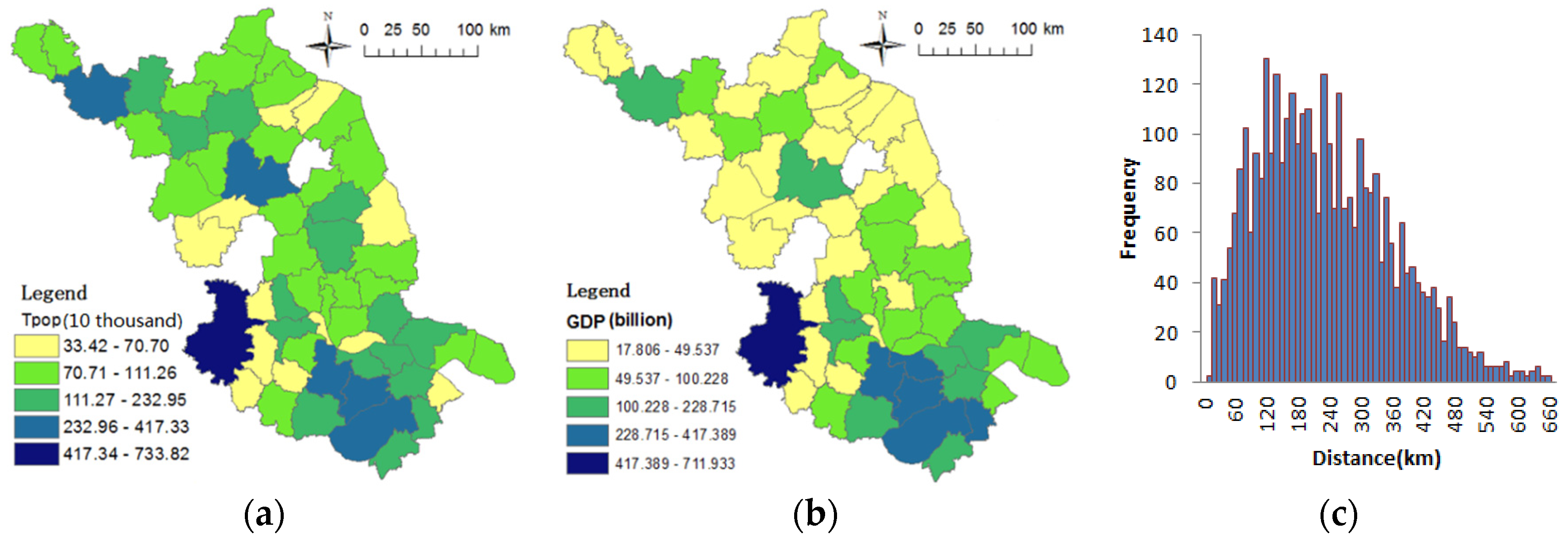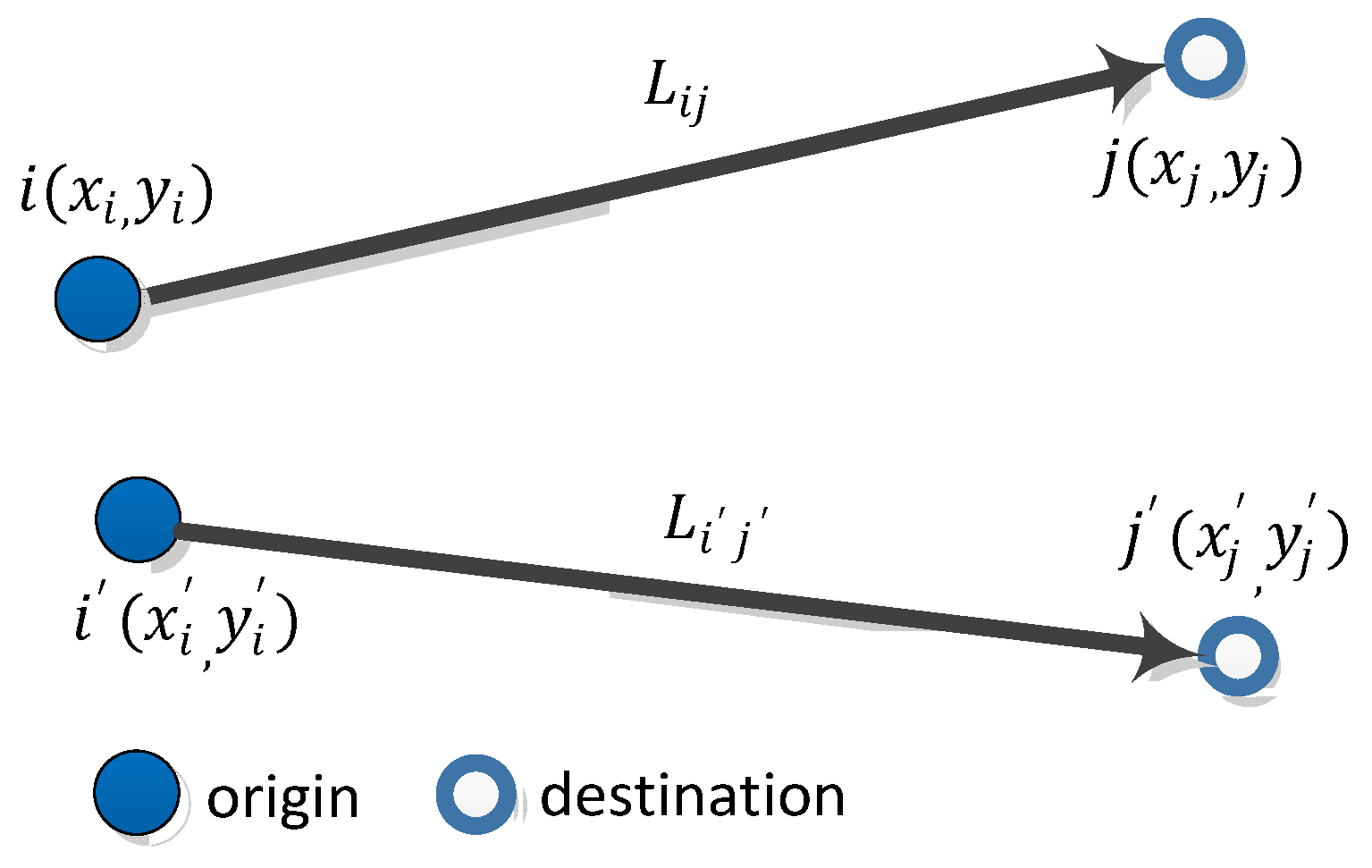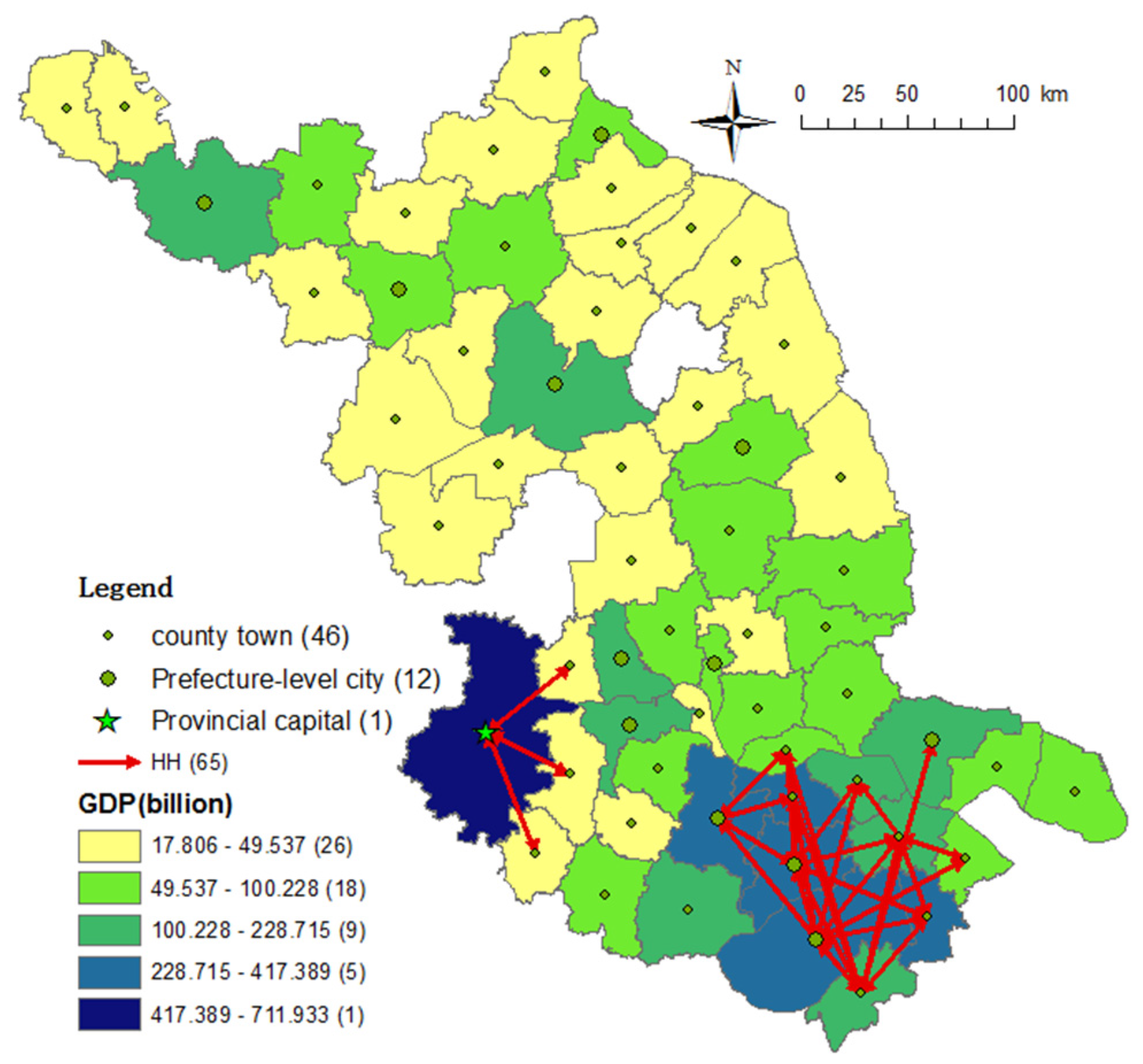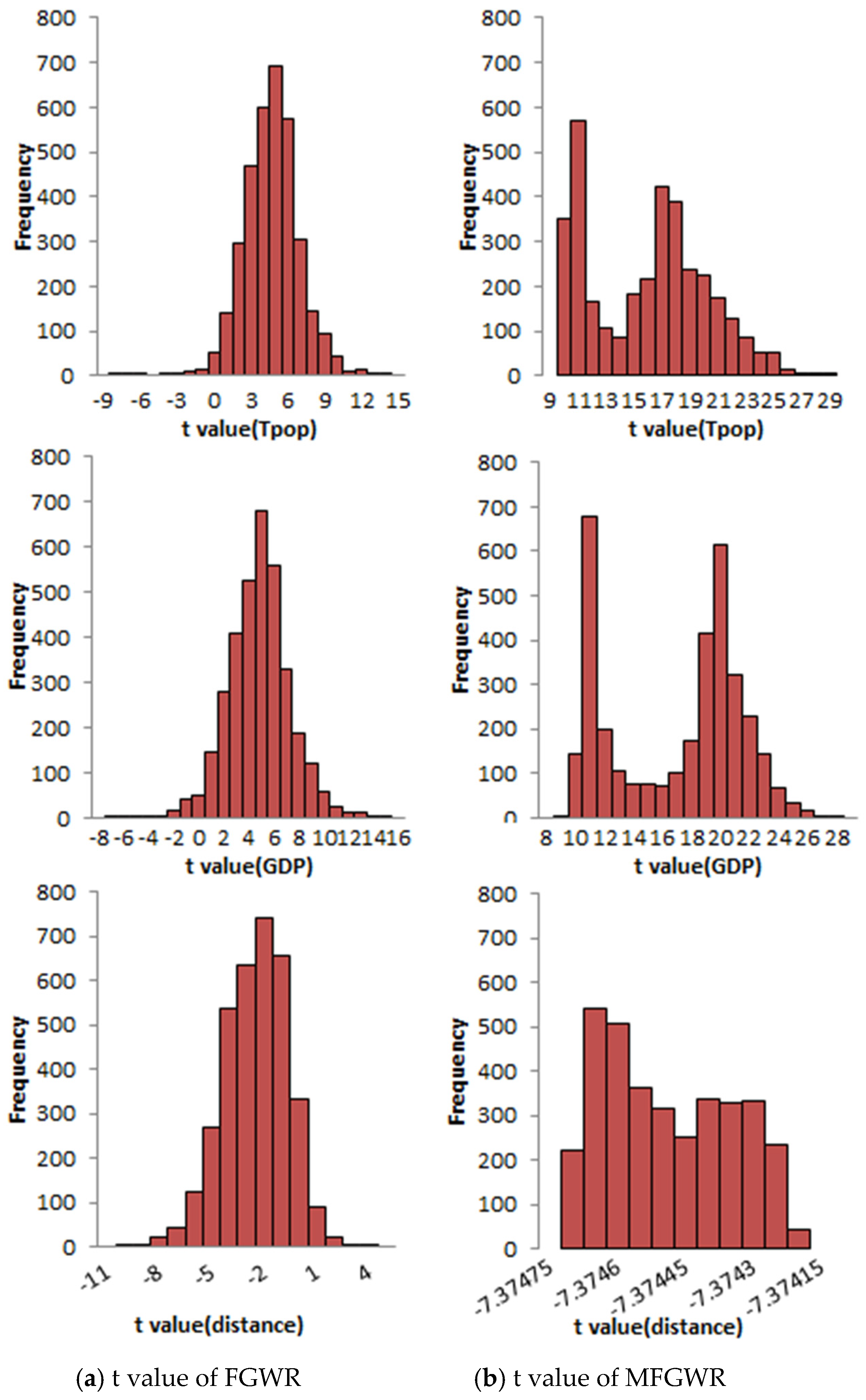3.2. Flow-Focused Global and Local Moran Indice
Global and local Moran Indices have become popular methods for measuring spatial autocorrelation, which is a form of spatial dependence. In this case study, both indices were employed for two purposes: detecting clustering patterns and defining clusters of flow, and examining the reduction of spatial auto-correlation in the residuals of global and local models of transport flows. The calculation of spatial autocorrelation depends on spatial weights. The distance threshold method is commonly used in the calculation of spatial weights.
Considering the unique spatial dependence of flows, spatial weight is defined by the spatial distance between OD flows [
31]. Equation (3) is used to calculate the spatial distance between flows. Adjacent OD flows within a specified critical distance will be given a weight and have a significant impact on the calculation of the target OD flow. Adjacent OD flows that exceed a specified critical distance will be assigned a weight of zero and will not have any effect on the calculation of the target OD flow. The calculation method of the space weight is called the fixed distance band, and its equation is as follows:
where b is the fixed distance band, which should satisfy the requirement of ensuring at least one adjacent flow for each flow, and
is the spatial distance between flow i and flow j. The Global Moran Indice is used to detect the pattern of transport flows: random, dispersed or clustered. The Local Moran Indice enables flows to be classified into four categories: HH (high-high), LL (low-low) and LH (low-high) and HL (high-low). HH means high volumes of flows are surrounded by a high volume of flows, and are therefore recognized as a hot cluster. Conversely, LL defines a cold cluster. LH and HL are defined as spatial outliers.
3.3. Multiscale Flow-Focused Geographically Weighted Regression
Spatial interaction modelling has been widely deployed to analyze various geographic mobilities (e.g., commuting, travel and migration). Currently, geographically weighted regression (GWR) [
15,
32] is the most commonly used model for geographical-weighted regression analysis. In this paper, the MGWR model was applied to the modelling of transport flow for the first time.
A simplified form of spatial interaction model is represented as follows (Equation (4)).
where
is the interaction intensity between i and j,
and
represent the push and pull forces at the origin place i and destination place j respectively,
denotes the distance between places i and j, and
is a distance decay function of
. In practice,
and
are often replaced by the scale of two places, e.g., population of origin and GDP of destination. Many studies argue that the distance decay function varies with spatial scales [
26]. The non-linear functions of quantifying the distance decay effect are dominated by an inverse power function and a negative exponential function. The former is more suitable for analyzing short distance interactions on the urban scale and the latter more suitable for analysing longer distance interactions (such as migration flow) on regional or national scales [
33]. For example, at urban scales, this distance decay function
is often expressed as an inverse power function, which is evidentially confirmed by ref. [
26]. At the regional scale (e.g., province in this study) the function
is better expressed as negative exponential function (e.g.,
), where β is the distance friction coefficient. The higher the value of β is, the more sensitive to distance the flow is.
In the case of transport flows at county level across a province, the pushing force at the county of origin is represented by its total population, , and the pulling force at the destination county by its total GDP, . A negative exponential function is suitable for the distance decay at the regional scale. The expressway network distance used for this case study was calculated using ArcGIS 10.5 Network Analyst.
The global model based on transport flow space interaction data is as follows (Equation (5)).
where k is the estimated intercept, α, β and γ are the parameters to be calibrated,
is the random error term, Tpop and GDP are explanatory variables where Tpop is the population of the county of origin and GDP is the GDP of the destination county. Other parameters are as described above.
The global models mentioned above take no account of spatial heterogeneity in the spatial interaction modelling. The spatial non-stationarity, a form of heterogeneity, which refers to the varying relationships between dependent and independent variables across the study area, can be explored by the innovative method of geographically weighted regression [
15,
32]. FGWR allows for spatial changes in parameters, and parameter calibration of the data in the vicinity of the data by “borrowing” nearby data. The FGWR model of spatial interaction data is defined as follows (Equation (6)).
where
,
,
,
are local parameters to be calibrated by GWR using flow-based distance and spatial weight described in
Section 3.1 and
Section 3.2.
Since there is only one bandwidth in FGWR, FGWR limits the local relationships in each model to the same spatial scale and does not take into account the conditional relationships between each independent variable nor does it account for the variation of across different spatial scales. The MGWR method allows conditional relationships between response variables and for predictors to vary across different spatial scales. Contrasting with the global spatial interaction models in Equations (4)–(6), a local model specification of the flow data using MFGWR, which is the application of MGWR into flow data, is defined in Equation (7).
where
indicates the bandwidth for calibration of the lth conditional relationship for
and ij represents the location of flow from origin site i to destination site j. That is to say, there are four explanatory variables (including a constant) in the MFGWR model of transport flow, so each explanatory variable has its own spatial bandwidth in the regression analysis. Each flow has a set of parameters together with other local statistics, such as residuals and
t-statistics.
In the case of MFGWR, its parameters are calibrated as follows (Equation (8));
where
is a
vector of observations for the dependent variable,
is an
vector of parameter estimates and
is an
matrix of explanatory variables as follows (Equation (9)).
Each row in the hat matrix S in the Gaussian GWR process is defined as Equation (10).
where
is the
row of X.
In equation (8),
is an n×n diagonal matrix of spatial weight for flow {ij} (Equation (11)). The spatial weight matrix is a data-borrowing scheme that allows the flow data closer to the flow {ij} position to have a stronger influence on the local regression.
There are two popular methods of calculating spatial weight
: fixed bandwidth and adaptive bandwidth. Fixed bandwidth aims to search for an optimal distance, within which all flows of ij will be calculated using a spatial weight
by following a Gaussian function (Equation (12))
where b is the optimal threshold distance, called bandwidth in this case, and
is the distance between flows i and j.
Adaptive bandwidth aims to search for the optimal number of nearest flows, which are used to determine the distance
for each flow i. It is clear that
is affected by the density of flows near flow i. In this case, its spatial weight is calculated by using a bi-square kernel function (Equation (13)). The process of searching for optimal bandwidth b or
is conducted by Golden Section until a minimum value of AICc has been reached [
15,
32].
Since only one bandwidth is required, the bandwidth selection in FGWR is relatively simple. The bandwidth selection in MFGWR is relatively complicated, because each explanatory variable needs an optimal bandwidth, and the relationship between explanatory variables should be considered. The optimal bandwidth is selected in the trial. Covariate-specific optimal bandwidths are estimated by minimizing the corrected AICc, which is defined as follows (Equation (14)),
where n is the number of flows, RSS is the residual sum of squares, and tr(S) is the trace of the hat matrix S.
3.4. Calibration of MFGWR
A back-fitting algorithm is commonly used for the calibration of generalized additive models [
21,
34,
35]. MFGWR is defined as follows (Equation (15)),
where y is a column vector of response variables,
is a column vector of random error terms, and each of the additional components
are the product of the elemental multiplications of the local parameters
and
which is
column of X (Equation (16)).
Initial coefficient estimate β and residual of MFGWR are taken from the calibration of the model by GWR [
21]. The definition of the convergence criterion for bandwidth optimization is as follows (Equation (17)).
The detailed description and implementation of the back-fitting algorithm can be found in [
21,
25].
Summarizing the above statement, in the case of spatially interactive transport flows, the MFGWR is defined as follows (Equation (18)).
where
is the interaction intensity between i and j, and
,
and
are explanatory variables.
and
present the push and pull forces at the origin place i and destination place j respectively.
3.5. Adjustments to the Critical Value of t Testing
In the FGWR framework, a
t-test can be performed for each parameter at each calibration location. This problem has become more complicated due to the potential dependence on local estimates [
23,
36]. An effective correction to the significance level
for the
t-tests has been proposed [
37]. The adjusted α value can be tried multiple times during the hypothesis test, including 90% (α = 0.1), 95% (α = 0.05) and 99% (α = 0.001) confidence. The adjusted value of α for the local
t-tests is given by:
where
is the desired error rate (i.e., 0.05), m is the number of parameters and ENP is the effective number of parameters.
and S is the hat matrix. If
; in all other situations α < ξ.
In the MFGWR framework, each covariate produces an
where
.
is the effective number of parameters for each covariate. Each covariate has its independent critical value
derived from the aforementioned
t-tests.
; in all other situations, < . This paper provides the first application of both MFGWR and its associated hypothesis testing framework for modeling spatial flows.














